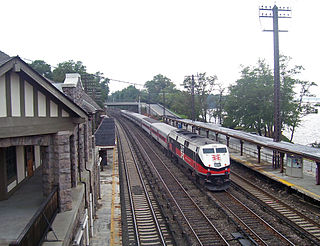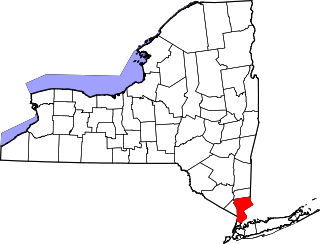Related Research Articles

Westchester County is located in the U.S. state of New York. It is the seventh most populous county in the State of New York and the most populous north of New York City. According to the 2020 United States Census, the county had a population of 1,004,456, its highest decennial count ever and an increase of 55,344 (5.8%) from the 949,113 counted in 2010. Located in the Hudson Valley, Westchester covers an area of 450 square miles (1,200 km2), consisting of six cities, 19 towns, and 23 villages. Established in 1683, Westchester was named after the city of Chester, England. The county seat is the city of White Plains, while the most populous municipality in the county is the city of Yonkers, with 211,569 residents per the 2020 census.

Sleepy Hollow is a village in the town of Mount Pleasant, Westchester County, New York, United States.

Mount Pleasant is a town in Westchester County, New York, United States, in the New York metropolitan area. As of the 2020 census, the town population was 44,436. The hamlets of Valhalla, Hawthorne, Pocantico Hills, and Thornwood, and the villages of Pleasantville, Sleepy Hollow, and a small portion of Briarcliff Manor lie within the town.

Tarrytown is a village in the town of Greenburgh in Westchester County, New York. It is located on the eastern bank of the Hudson River, approximately 25 miles (40 km) north of Midtown Manhattan in New York City, and is served by a stop on the Metro-North Hudson Line. To the north of Tarrytown is the village of Sleepy Hollow, to the south the village of Irvington and to the east unincorporated parts of Greenburgh. The Tappan Zee Bridge crosses the Hudson at Tarrytown, carrying the New York State Thruway to South Nyack, Rockland County and points in Upstate New York. The population was 11,860 at the 2020 census.

Philipse Manor station is a commuter rail stop on the Metro-North Railroad's Hudson Line, located in the Philipse Manor area of Sleepy Hollow, New York, United States.

Kykuit, known also as the John D. Rockefeller Estate, is a 40-room historic house museum in Pocantico Hills, a hamlet in the town of Mount Pleasant, New York 25 miles (40 km) north of New York City. The house was built for oil tycoon and Rockefeller family patriarch John D. Rockefeller. Conceived largely by his son, John D. Rockefeller Jr., and enriched by the art collection of the third-generation scion, Governor of New York, and Vice President of the United States, Nelson Rockefeller, it was home to four generations of the family. The house is a National Historic Landmark owned by the National Trust for Historic Preservation, and tours are given by Historic Hudson Valley.

Wolfert Acker (1667–1753) was a colonial-period American who is featured in Washington Irving's short story collection Wolfert's Roost and Miscellanies (1855). His name was recorded in all combinations of Wolfert or Wolvert as given name, and Acker, Echert, Eckar, or Ecker as surname. He was born in Flatbush, Brooklyn, New York and died at his sizable home, "Wolfert's Roost" near the site of what is now Irvington, New York in Westchester County, New York. On December 20, 1692, on land belonging to Frederick Philipse, he married Maretje Sibouts.

Rockefeller State Park Preserve is a state park in Mount Pleasant, New York in the eastern foothills of the Hudson River in Westchester County. Common activities in the park include horse-riding, walking, jogging, running, bird-watching, and fishing. The park has a rich history and was donated to the State of New York over time by the Rockefeller family beginning in 1983. A section of the park, the Rockwood Hall property, fronts the Hudson River. It was formerly the private residence of William Rockefeller, and began use as a New York state park in the early 1970s. In 2018, the park was added to New York's State Register of Historic Places.

Pierre Van Cortlandt was an American politician who served as the first lieutenant governor of New York.

Sunnyside (1835) is an historic house on 10 acres along the Hudson River, in Tarrytown, New York. It was the home of the American author Washington Irving, best known for his short stories, such as "Rip Van Winkle" (1819) and "The Legend of Sleepy Hollow" (1820).

Philipsburg Manor House is a historic house in the Upper Mills section of the former sprawling Colonial-era estate known as Philipsburg Manor. Together with a water mill and trading site the house is operated as a non-profit museum by Historic Hudson Valley. It is located on US 9 in the village of Sleepy Hollow, New York.

The Old Dutch Church of Sleepy Hollow (Dutch: Oude Nederlandse Kerk van Sleepy Hollow), listed on the National Register of Historic Places as Dutch Reformed Church (Sleepy Hollow), is a 17th-century stone church located on Albany Post Road (U.S. Route 9) in Sleepy Hollow, New York, United States. It and its three-acre (1.2 ha) churchyard feature prominently in Washington Irving's 1820 short story "The Legend of Sleepy Hollow". The churchyard is often confused with the contiguous but separate Sleepy Hollow Cemetery.

Pocantico Hills is a hamlet in the Westchester County town of Mount Pleasant, New York, United States.
The Hudson Independent is a monthly newspaper serving the Westchester communities of Tarrytown, Sleepy Hollow, Irvington, Dobbs Ferry, Ardsley-on-Hudson, Pocantico Hills, and Scarborough-on-Hudson. It is published by The Hudson Valley News Corporation and distributed to every home and business in the villages as well as subscribers outside the region.

New York State Route 448 (NY 448) is a 3.90-mile (6.28 km) long state highway in western Westchester County, New York, in the United States. The route begins in the village of Sleepy Hollow at U.S. Route 9 (US 9) and goes in a northeast direction through the Pocantico Hills community in Mount Pleasant. It ends at NY 117 in Mount Pleasant, near the junction of NY 117 with Saw Mill River Road and the Taconic State Parkway. From 1930 to November 1970, NY 448 was part of NY 117.

Union Church of Pocantico Hills is a historic church in Pocantico Hills, New York. The church was built by John D. Rockefeller Jr. in 1921, as part of his plans to develop the town of Pocantico Hills, which was below his estate Kykuit. Upon the death of Rockefeller's wife Abby Aldrich Rockefeller in 1948, their son Nelson Rockefeller commissioned Henri Matisse to design the church's rose window in honor of her memory shortly before the artist's own death in 1954. When John D. Rockefeller Jr. died in 1960, his children commissioned artist Marc Chagall to design a Good Samaritan window in his honor. It is a one-story neo-Gothic style building with fieldstone foundation and walls and a slate covered, highly pitched gable roof. In 1930–1931, a parish hall was added to the east end of the church.

Philipsburg Manor was a manor located north of New York City in Westchester County in the Province of New York. Netherlands-born Frederick Philipse I and two partners made the initial purchase of land that had been part of a Dutch patroonship owned by Adriaen van der Donck. Philipse subsequently bought his partners out and added more land before being granted a royal charter in 1693 for the 52,000 acres (21,000 ha) estate, becoming its first lord.

This is a list of the National Register of Historic Places listings in northern Westchester County, New York, excluding the city of Peekskill, which has its own list.

The Pocantico River is a nine-mile-long (14 km) tributary of the Hudson River in western central Westchester County, New York, United States. It rises from Echo Lake, in the town of New Castle south of the hamlet of Millwood, and flows generally southwest past Briarcliff Manor to its outlet at Sleepy Hollow. Portions of the towns of Mount Pleasant and Ossining are within its 16-square-mile (41 km2) watershed.
There are numerous nationally and locally designated historic sites and attractions in Westchester County. These include architecturally significant manors and estates, churches, cemeteries, farmhouses, African-American heritage sites, and underground railroad depots and waystations. There are sites from pre-Revolutionary and Revolutionary times, as well as battlegrounds. Westchester County also played an important role in the development of the modern suburb, and there are many associated heritage sites and museums.
References
- ↑ "About". Historic Hudson Valley.
- ↑ Ames, Lynne (1991-08-25). "Sunnyside Visitors Regain Access to Tower". The New York Times. ISSN 0362-4331 . Retrieved 2023-04-03.
- ↑ "Press Release: Bard College Finalizes Purchase of Montgomery Place". Bard.edu. 12 January 2016. Retrieved 2 June 2017.
- ↑ Strom, Stephanie (November 16, 2009). "A Revolutionary War Widow's Estate Becomes a Preservation Battleground". The New York Times . Retrieved 2009-11-17.
- ↑ "School Programs". Historic Hudson Valley.
- ↑ "What is CORNucopia?". Historic Hudson Valley.
- ↑ "Dickens's 'Christmas Carol'". Historic Hudson Valley.
- ↑ "Celebrate Pinkster". Historic Hudson Valley.
- ↑ "Sheep to Shawl". Historic Hudson Valley.
- ↑ "The Great Jack O'Lantern Blaze". Historic Hudson Valley.
- ↑ "Horseman's Hollow". Historic Hudson Valley.
- ↑ "Top 10 Halloween Attractions in Sleepy Hollow Country". Historic Hudson Valley.
- ↑ "Irving's Legend". Historic Hudson Valley.